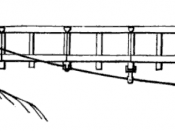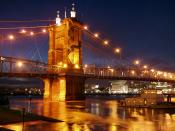Suspension Bridges A suspension bridge is a one where many cables are strung across two or more towers, which supports the majority of the bridge weight and force. The cables run from the towers to the anchorages.
Suspension bridges have benefited our everyday lives since John A. Roebling perfected the suspension bridge design in 1845 and built the Allegheny Suspension Bridge in Pittsburgh, Pennsylvania (Placzek). These bridges are better than previous bridges in many ways. Suspension bridges can span greater distances and are much cheaper than other types of bridges, such as beam bridges, which are simply constructed of beams supporting the deck of the bridge, they cannot span as long as these suspension bridges, and are more costly due to the amount of steel used. Without these bridges, some of today's largest gaps could not be crossed by use of a bridge.
Suspension bridges are no more than physics in action.
The force of compression pushes down on the suspension bridge's deck, but because it is a suspended roadway, the cables transfer the compression to the anchorages which place the compression directly into the earth where they are firmly planted. The supporting cables, running between the two anchorages, are the recipients of the tension forces. The cables are stretched from the weight of the bridge and its traffic as they run from anchorage to anchorage. The anchorages are also under tension, but since they, like the towers are held firmly to the earth, the tension is placed into the earth. Almost all suspension bridges also have a truss system underneath the bridge deck to help stiffen the bridge and prevent swaying.
There are two types of suspension bridges. The more common "M" design where the cables are strung in a "M"- like fashion. The other, and the more rare design of the two, is the "A" design. In this design, two towers and four anchorages are not needed, like the "M" design, but the wires run up from the roadway to a single tower where they are secured. (Brain) Current suspension bridge designs have many types of wires and the type of wire used depend on the size of the bridge. Galvanized Bridge Wire is the basic wire. Galvanized Bridge Wire is twisted together to form Galvanized Bridge Strands. Galvanized Bridge Rope is formed by twisting Galvanized Bridge Strands. These different "strengths" of wire are used in making the actual cables of the bridges. There are five main types of cables in a suspension bridge. The first type is Parallel Wire Cables, which consist of Galvanized Bridge Wire placed in a "tubing." The wires are not twisted, just placed next to each other to make a cable. The second type of cable is Parallel Strand Cables, Closed Construction. These consist of many Galvanized Bridge Strands laid parallel and in contact with each other. The next type, Parallel Strand Cables, Open Construction, is the same as the Closed Construction except the strands are not in contact with each other. The forth kind, Parallel Rope Cables, Open Construction, are the same as Parallel Strand Cables except Galvanized Bridge Rope is used in place of Galvanized Bridge Rope. The final type of cable is the Single Rope or Single Strand Cable, which is a single rope or strand. The Single Rope is used for smaller structures. Each type of cable is used for the size and strength needed for the bridge that is being made. The current towers are long and tall beams of steel placed upright on the bridge. The anchorages are also made of steel. (Technical Data) Future suspension bridge designs may replace the steel wires, towers, and anchorages with carbon-fiber ones. Carbon-fiber is a very strong and very light material. With carbon-fiber cables, the cables could support a lot more force than the current cables and, in turn, will enable suspension bridge lengths to exceed even the record-breaking distances of today's designs, like the Akashi Kaikyo Bridge in Japan which holds the record for longest bridge. It spans about 12,828 feet, and with the materials of today suspension bridges can exceed even that distance (Bridge Information).
Suspension bridges have spanned the gaps which were thought to have been impossible, like the gap of the Tagus River in Portugal. In order to improve these modern marvels stronger materials must be used in order for the bridge length to increase and to fight the many forces which act upon the bridges.
Bibliography Brain, Marshall "Howstuffworks: How Bridges Work" http://www.howstuffworks.com/bridge4.htm "Bridge Information" http://www.overrev.com/rotary/maikopark/English/bridgeinfo_e.html Bridge Types: Suspension" http://www.matsuo-bridge.co.jp/english/bridges/basics/suspension.shtm Placzek, Adolf K. "John Augustus Roebling - Great Buildings Online" http://www.greatbuildings.com/architects/John_Augustus_Roebling.html Steinman, David Barnard "Enclyclopedia Brittanica Intermediate - BRIDGE" http://search.ebi.eb.com/ebi/article/0,6101,32499,00.html "Suspension Bridge Technical Data" http://www.inventionfactory.com/history/RHAbridg/sbtd/





